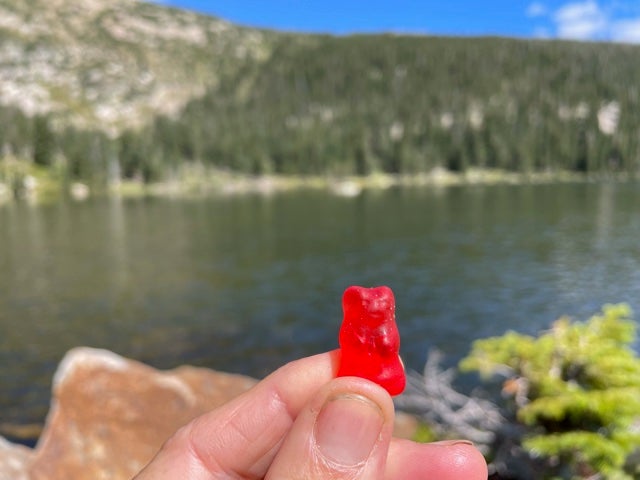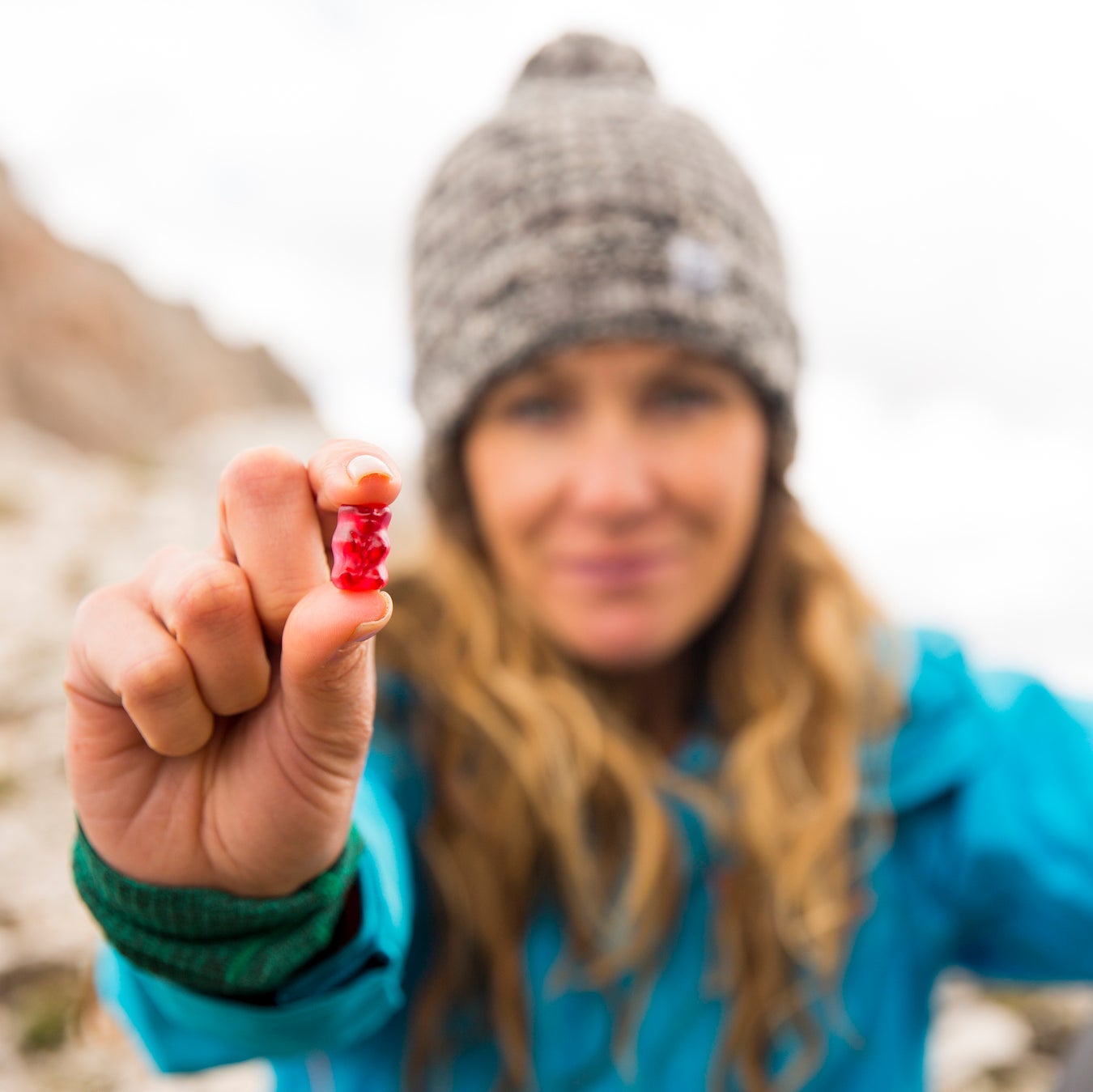I personally used gummy bears as endurance fuel for a solid ten years. These adorable chewy candies have long been a solution for athletes seeking an inexpensive and sugar-rich fuel for prolonged endeavors. But with more sport-formulated gummy options like Clif Bloks and Honey Stinger Chews on the market than ever, I wondered if there was much of a difference in how they make me feel during hearty efforts. So I decided to put them to a head-to-head test.
Running with Gummy Bears
It was 10 a.m. at a pristine mountain lake in Colorado when I ate my first convenience store gummy bears, and—no surprise here—they were delicious. I’d packed a reusable plastic bag with a heartier serving (read: more than the recommended nine bears) of Albanese Gummi Bears, and another reusable bag of Haribo Goldbears and shoved them in my hydration pack. This type of candy is usually made of corn syrup and sugar, with “natural and artificial flavors.”
I was a couple rugged mountain miles to a lake with my dog. I sat on a rock and ingested the candy, noting how the Albanese Gummi Bears, which a friend had raved about to me, were insanely soft and chewy. Maybe too soft and chewy—I ate all of them within 30 seconds. They don’t require a lot of masticating, which is a bonus while running, but a negative if you don’t want to inhale a giant bag of gummy bears in one sitting.
I also ate a few (again more than nine) Haribo Goldbears. This is the brand I used to carry and eat during multi-day adventure races. They are, in a word, gummier. They take more effort to chew, which is fine while hiking or paddling, but can be a pain (and a choking hazard) while running or cycling. They too, are delicious (I’m personally partial to the pineapple flavor).
The consumption left my teeth feeling slimy, like they do whenever I eat something super-sugary. My stomach felt OK—not great—on the steep and rocky descent, but I felt a little jittery, like I’d had too much coffee.
I didn’t crash and burn afterward, but it was only a five-mile outing. I didn’t feel great the rest of the day, though.

Running with Energy Chews
Since energy chews hit the scene some years ago, I’ve relied on them to both satiate my love of gummy candy while exercising and to keep me going. I’ve used them on countless mountain running adventures, ski tours, hikes with kids, and more. But for this gummy-to-gummy comparison, I took them on a mountain run three days after the initial gummy bear test.
I ate a sleeve full of Salted Watermelon Clif Bloks about six miles into a rugged run towards another alpine lake. And I pounded a bag of Honey Stinger Pink Lemonade Energy Chews around mile 11.
Both served my needs: I was fatigued and hungry, sweating profusely, and borderline depleted. I ate more on that 15-mile run than just chews—some nuts, pretzels, zucchini bread with walnuts—but the chews were my on-the-go snacks while the others I ate sitting at a lake or walking to warm-up.
I didn’t get the sugary coating on my teeth; I don’t from chews. And I didn’t get the weird jitters. I also didn’t feel the guilt-cheating sensation I had on my Gummy Bear Run. The ingredients of both Clif Bloks and Honey Stinger Energy Chews include feel-good sugars like organic tapioca syrup, organic sugar, and organic honey, plus organic color from black carrot juice.
Bears Versus Chews
| Albanese Gummi Bears | Haribo Goldbears | Salted Watermelon Clif Bloks Energy Chews | Pink Lemonade Honey Stinger Energy Chews | |
| Cost | $.48/oz | $0.31/oz | $1.52/oz | $1.63/oz |
| Sodium | 20mg / 9 bears | 5mg / 13 bears | 100mg per serving (3 chews) or 200mg per pack (6 chews) | 65mg of per serving (6 chews) / 130mg per pack (12 chews) |
| Carbohydrates | 29g / 9 bears | 23 / 13 bears | 24 grams / pack | 39 grams / pack |
| Calories | 100 / 9 bears | 100 / 13 bears | 180 calories / pack | 160 calories / pack |
| Sugar | 14g / 9 bears | 14g / 13 bears | 24 grams | 27 grams |
Aside from the better sugars and ingredients in general of energy chews, what both packs of chews have that gummy bears do not are a substantial amount of electrolytes. I feel like I need the extra sodium provided by chews when I exert myself; replacing it helps me feel balanced.
There is less sugar in the full bag (two servings) of both Clif Bloks and Honey Stinger Energy Chews than in two servings of gummy bears. (Those two servings would be a count of 18 bears.) I’m not sure why the sugar of chews doesn’t make me feel jittery and gross like the sugar of gummy bears. Maybe it’s partially psychosomatic, but maybe it has to do with the good things chews have that bears do not.
Honey Stinger chews also provide 70 percent the recommended dietary allowance of Vitamin C, and their new Caffeinated Chews (Strawberry Kiwi, Cherry Cola, and Stingerita Lime) contain 50 milligrams of caffeine (100 milligrams for whole pack) from tea for sustained energy. Black Cherry contains 50 milligrams caffeine per serving (100 milligrams per pack), while Tropical Punch and Orange Clif Bloks contain 25 milligrams caffeine per serving (50 mg per pack). And Clif Bloks have 18 milligrams of potassium, also beneficial electrolytes. (Strangely, Haribo Goldbears have two grams of protein per serving.)
Where Haribo and Albanese have an edge is in cost and availability. You can buy bears from those brands in a variety of stores and cost less than half per ounce than any of the chews, which are more of a specialty item.
Final Thoughts
I feel better eating energy chews over gummy bears, both on an endurance/performance level and on a guilt level, not that I, or anyone, should feel guilty eating candy once in a while. The only thing I might feel guilty about is the extra cost that I might incur during a race or an intense training cycle.
I find energy chews just as delicious as gummy bears, and both feel like a treat while out on an adventure of any sort. The energy chews don’t coat my teeth in sugar or threaten a sour belly, something I get when I ingest too much sugar on a run. Eating energy chews on a run or any outing that requires endurance just makes more sense than eating gummy bears.
Our veteran gear maven, Lisa Jhung, has been testing gear for 25 years. She’s sprayed herself down with a hose to test the waterproofness of rain jackets, set up treadmills in her yard for weeks of testing, and stashed shoes in bushes to change mid-run.
In this column, Vetted, she inspects, tests, and muses on all things outdoor gear.

